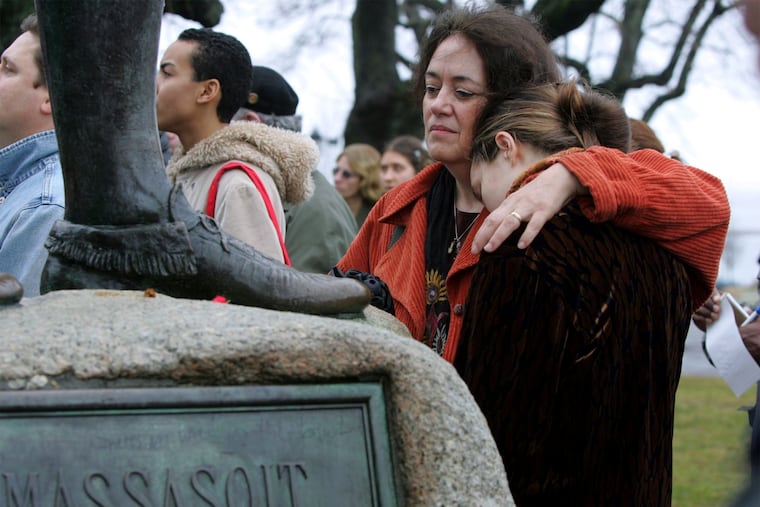What’s the Thanksgiving story from the perspective of Native Americans?
As the story goes that’s been taught in American schools, the Pilgrims marked their first harvest in a three-day celebration with the Wampanoag tribe in 1621. But what is the Native American perspective?

At noon on Thanksgiving, a group of Native Americans and their allies will gather at Cole’s Hill above Plymouth Rock, next to a statue of Massasoit — chief of the Wampanoag nation when the Pilgrims arrived in 1620.
But it’s not to celebrate. Instead, they will take part in a solemn observation of the 50th National Day of Mourning.
“We remember the millions of our ancestors who were murdered by uninvited European colonists such as the Pilgrims,” said Moonanum James, co-leader of the United American Indians of New England, in a statement. “Today, we, and many indigenous people around the country, say, ‘No Thanks, No Giving.’”
What is the traditional Thanksgiving story?
What most people learned in school is the story of a 1621 peaceful gathering between the Pilgrims and Native Americans, celebrating that the Pilgrims had survived their first winter in Massachusetts.
What are the other versions of this story?
According to a 2011 story in Indian Country Today, Massasoit met with the Pilgrims only after gunfire was heard coming from their village. When the Wampanoag arrived, they were invited to join the meal, but there was not enough food, so Massasoit sent people out and they returned with five deer. That was the exchange of gifts. And that was in March, not in November.
Ruth Hopkins, a Native American writer and lawyer and member of the Great Sioux Nation, says the holiday originated after a massacre that killed 700 Pequot in 1637. Months earlier, a white privateer was found dead in his boat, and the colonists blamed the Pequot, who lived at what is now Mystic, Conn.
» READ MORE: Telling a Native story from Native perspectives: Revisiting Pennsylvania’s Conestoga massacre | Opinion
In retaliation, settlers, assisted by Mohegan and Narragansett warriors, attacked the Pequot village and burned their houses in a predawn raid on May 26, while most were asleep. Hopkins said John Winthrop, governor of the Massachusetts Bay Colony, proclaimed a day of thanksgiving for the end of the fighting and the safe return of the soldiers.
“The 12th of the 8th m.[onth] was ordered to be kept a day of publicke thanksgiving to God for his great m’cies in subdewing the Pecoits, bringing the soldiers in safety, the successe of the conference...,” according to a journal of Winthrop’s.
Alternatively, some historians report that Winthrop first called for a day of thanksgiving as early as July 8, 1630, to give thanks for ships that had arrived safely from England after a stormy voyage.
How did it become a national holiday?
Presidents George Washington and Abraham Lincoln both called for a day of thanksgiving in the aftermath of war.
Washington issued a thanksgiving proclamation after the Revolutionary War on Oct. 3, 1789, designating for “the People of the United States a day of public thanks-giving” to be held on "the 26th day of November.” in that year.
On Oct. 3, 1863, in gratitude for the Union victory at Gettysburg, Lincoln proclaimed Thanksgiving as a national holiday to be celebrated on Nov. 26, 1863.
How do Native Americans mark the holiday?
Native Americans were having harvest feasts hundreds of years before the colonists arrived.
Hopkins said many of the Sioux Nation, who live in the Dakotas, Montana and Minnesota, gather and share a meal. But it will be in the spirit of gratefulness for food and life.
Many tribes don’t mark the holiday.
Hopkins said children in tribal schools learn early the stories about how Thanksgiving began, and the violence that came with it.
"We have to make sure they know the truth. Most schools gloss over the genocide of indigenous people and slavery. Some people say we should not teach actual history, because it’s too wicked and it’s too hard. But it’s better off they know the truth, depending on the child’s level of understanding.
“It does a disservice to start them off on deception and myths.”
In the Philadelphia area, where the Lenni-Lenape live, a representative of the nation could not be reached for comment.
How did the National Day of Mourning start?
The first National Day of Mourning took place in September 1970, when Wamsutta Frank James was invited to give a speech to observe the 350th anniversary of the Pilgrims’ arrival in 1620.
When organizers of the event looked at James’ speech, they asked him to rewrite it. “They said, 'Well, we can’t allow you to read that, 'cause 90% of the people would walk out," Tall Oak of the Aquinnah Wampanoag tribe told CNN in a recent article.
The group United American Indians published the speech on its website under the heading, “The Suppressed Speech of Wamsutta (Frank B.) James, Wampanoag, To have been delivered at Plymouth, Massachusetts, 1970.”
James never delivered the speech and walked out. That became the first National Day of Mourning.
What happens on the National Day of Mourning?
By custom, marches and speeches will address current issues.
On Thursday, the program near Plymouth Rock will be "dedicated to missing and murdered indigenous women, girls and two spirits, and to our thousands of relatives who are migrants and are being abused by ICE and other government agencies, including having their children stolen from them,” the website says.
In North Dakota, Hopkins said, some Native Americans also call the day “Thanks-Taking Day.”